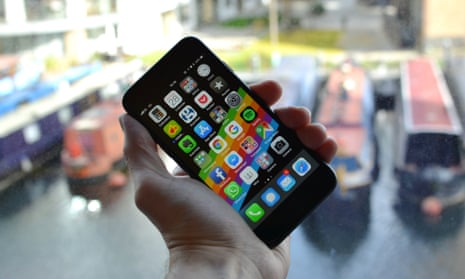Another year, another iPhone, except this time there are three of them. The iPhone 8 is the first out of the gate, but it’s overshadowed by the iPhone X looming in the wings, and while there are some new elements – a glass back – you could be forgiven for feeling a bit of deja vu.
Placing all the recent iPhones side by side, from 2014’s iPhone 6, to 2015’s iPhone 6S and 2016’s iPhone 7 and on to the 8, it’s clear very little has changed on the outside.
2014 design
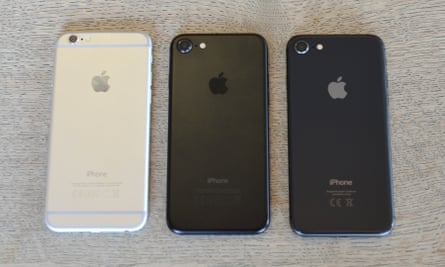
The iPhone 8 is fractions of a millimetre larger in every direction than the iPhone 7. It’s also 10g heavier than the iPhone 7, 5g heavier than the iPhone 6S and 19g heavier than the iPhone 6. Some will tell you that you can notice the difference, but that it’s a good weight. You can’t, and it doesn’t matter.
Because of its 2014 design, the iPhone 8 looks and feels outdated compared to sleeker, more modern rivals, despite still being immaculately made. The large bezels top, bottom and at the sides make the iPhone 8 look almost retro, and not in a good way.
The back of the iPhone 8 is glass, which inevitably makes it more fragile, but to what degree remains to be seen. In terms of the device’s feel, the glass is a double-edged sword. It’s less slippery in the hand than the metal of the iPhone 7, but I found it slipping off sofas, desks and other not-quite-level objects more easily. You’ll probably want to buy a case.
The screen looks great for an LCD and now has Apple’s True Tone system from the iPad Pro, which alters the colours of the display based on the ambient light. Samsung and competitors have had similar systems on their smartphones for years, and it makes the screen more attractive but sacrifices colour accuracy.
Specifications
- Screen: 4.7in LCD 1334x750 (326ppi)
- Processor: Apple A11 Bionic
- RAM: 2GB of RAM
- Storage: 64/256GB
- Operating system: iOS 11
- Camera: 12MP rear camera, 7MP front-facing camera
- Connectivity: LTE, Wi-Fiac, NFC, Bluetooth 5, Lightning and GPS
- Dimensions: 138.4 x 67.3 x 7.3mm
- Weight: 148g
Improved battery life
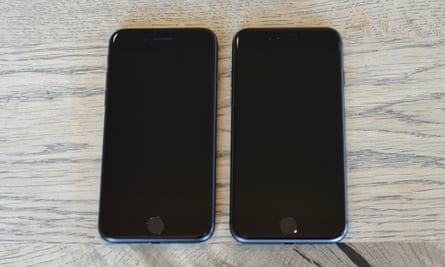
The iPhone 8 has Apple’s latest and best processor. The six-core A11 Bionic has two high-performance cores and four power-efficient cores and is apparently the most powerful so far because it can use a combination of all six at once.
Performance was excellent, but I struggled to see a real difference in day-to-day speed compared to the iPhone 7. But what I’m very pleased to be able to report is that Apple has finally improved battery life for the 4.7in iPhone.
We’re not talking a two-day battery here, but the iPhone 8 lasted just over 26 hours - setting off at 7am in the morning the phone would make it all the way through to around 9am the next morning without needing to be charged. That was while using it as my primary device and receiving hundreds of push notifications, taking 10 or so photos, watching a 45-minute burst of Netflix, making a short phone call, playing a quick game and listening to around 5 hours of Spotify with Bluetooth earbuds.
It was such a difference to the poor, 14-hour battery life of the iPhone 7 that I re-tested an admittedly year-old iPhone 7 with iOS 11 to see if the new software was responsible. It wasn’t – the iPhone 7 still doesn’t last until bedtime under the same conditions.
Anecdotally, I saw significantly better battery life on a cellular connection, with my hour-plus train journey in the morning consuming just 10% of the iPhone 8’s battery compared to 25% of the iPhone 7’s battery. If, like me, you spend a reasonable amount of the day actively using a smartphone on a 4G connection rather than wifi, then I suspect you will see similar results.
It’s worth noting that almost all of the iPhone’s rivals last longer between charges, and that while the iPhone 8 may last at least 24 hours when new, two years down the road it might be a different story as the battery starts to lose capacity.
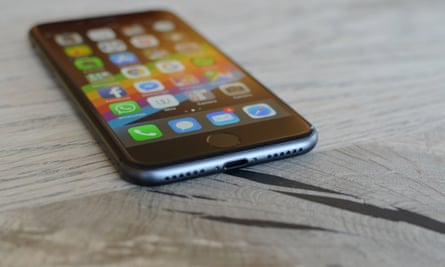
When the battery is dead, the iPhone 8 will charge much faster using a USB-C charger with Power Delivery, such as those used for the Google Pixel or USB-C charged laptops and tablets. Unfortunately neither the required USB-C to Lightning cable nor a fast charger comes in the box.
The big new feature for the iPhone 8 is wireless charging, something rivals have supported for five years. It works great, particularly using furniture with built-in wireless charging pads - you simply plonk it down on the spot and it starts to charge. I think it should be built into everything, so it’s good to see Apple finally get on board.
iOS 11
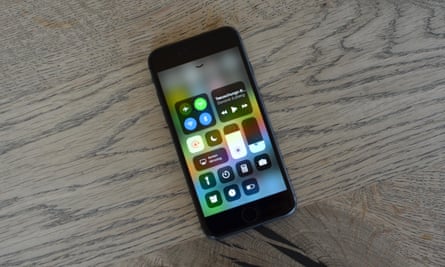
Not a vast amount has changed within iOS 11 compared to last year’s iOS 10, and most of the meaningful things are confined to the iPad.
For the iPhone 8 (and iPhone 6, 6S and 7 with an update), there’s the new Control Centre, which doesn’t actually turn off wifi or Bluetooth when you think it might, but works well for what it’s meant to be able to do. You still cannot get from Control Centre directly into the Settings app, an oversight that continues to baffle me, but you can customise a few things such as whether the flashlight toggle or low power mode switch is visible.
There’s a new optional setup routine for migrating from one iPhone to the next, if they’re both running iOS 11. Put them close by, they find each other via Bluetooth and then take a photo of the screen of one with the other. You’re prompted to run a backup on the old phone to then transfer it to the new phone. It works well as long as you have good wifi, but you still have to input passwords for your non-Apple accounts.
Overall, iOS 11 is pretty much the same iOS that we’ve seen for a few years, with a few small improvements here and there.
Camera
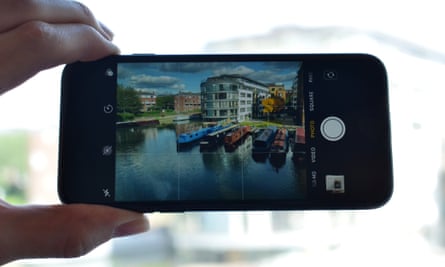
The iPhone 8 has an improved 12-megapixel camera on the back, which has a physically larger sensor and now has optical image stabilisation (OIS) – a feature previously reserved for the Plus variants of recent iPhones.
Overall this is certainly the best camera fitted to a 4.7in iPhone to date. OIS helps greatly with blur in the event of shaking hands or dim lighting and the larger sensor consistently picked up more light for better low-light photos.
Good lighting produced some brilliantly detailed and coloured photos. The HDR mode is now on by default and I got markedly better results with the iPhone 8 than I did the iPhone 7. If you’re upgrading from the iPhone 6S or earlier, you should be able to notice even off-the-cuff photos looking better.
The iPhone 8 easily has one of the best cameras on the market. I still get more consistently brilliant images from Google’s HDR+ system on the Pixel, but it is very close.
The 7-megapixel selfie camera is one of the best I’ve tested to date, preserving more skin detail than most rivals. While I like rich detail in my selfies, some might not find the iPhone 8 as flattering as they might want, but you can always soften details after the fact.
Also worth mentioning is the excellent 240fps slow motion video, which is now captured at 1080p resulting in markedly crisper videos, particularly when shot up close to an object.
Observations
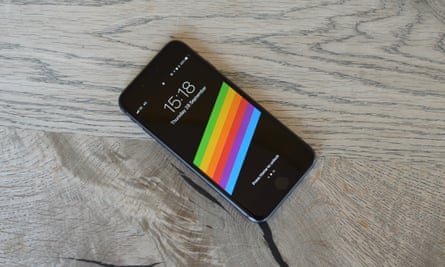
- The stereo speakers are meant to be louder, but I couldn’t really tell; I suspect the kids at the back of the bus will love it
- iOS 11 increased the size of some fonts used for marking out certain things such as the “Inbox” label at the top of the screen in Mail above the search bar – on the iPhone 8 it takes up quite a bit of space unnecessarily and is clearly designed to cater for the iPhone X’s notch
- The iPhone 8 is water resistant, but there’s still no headphone jack
- The glass back is a fingerprint magnet
- The iPhone 8’s battery dropped by 15% while dormant for 8 hours overnight
Price
The iPhone 8 costs £699 with 64GB of storage or £849 with 256GB of storage, and comes in three colours : silver, gold and black (“space grey”).
For comparison, that’s £100 more for the cheapest version of the iPhone 8 than last year’s iPhone 7 (but the iPhone 8 comes with twice the storage). The Samsung Galaxy S8 with 64GB of storage costs under £540 and LG’s G6 with 32GB of storage costs under £430. Google’s £599 Pixel is about to be replaced.
Verdict
The iPhone 8 is the best iPhone released to date because it has much better battery life, an improved camera and wireless charging – but it’s inherently boring. It has glass on the back, sure, but even without sticking it in a case it’s difficult to tell for the casual observer.
So what you’re buying for your not inconsiderable £699 or more is a 2014 design with the guts of a more modern smartphone. Some will tell you that’s fine, that it’s meant to be boring, that it’s still an iPhone. But I think if you’re spending £700 you can and should expect more than that.
There are plenty of equally boring smartphones that cost under £200 (and some brilliant ones costing around £500) . The problem is that if you’re an iPhone buyer looking for the latest Apple smartphone you probably won’t consider the notion of buying elsewhere, which leaves you stuck. Do you a) stick with the phone you’ve got, which is a good option if it’s still going strong; b) buy a £700 phone and live with the fact that it’s less exciting than a new paint job; c) buy an iPhone 8 Plus just for a change; or d) wait till November and take a punt on the even more expensive £999 iPhone X.
But just keep telling yourself: at least this year’s 4.7in iPhone lasts a good day on a single charge.
Pros: 24-hour-plus battery, great camera, wireless charging, fingerprint scanner, water resistant
Cons: 2014 design, boring, large bezels around the screen, no headphone jack, no fast-charger in the box, expensive
Other reviews
- Samsung Galaxy S8 review: the future of smartphones
- Google Pixel review: an iPhone beater but not quite an Android king
- Huawei P10 review: a good but not groundbreaking phone
- iPhone 7 review: how good can a phone be if the battery doesn’t last even a day?
This article contains affiliate links to products. Our journalism is independent and is never written to promote these products although we may earn a small commission if a reader makes a purchase.
